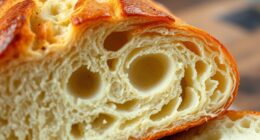As a passionate cook and baker, I’ve always viewed butter melting points as the secret ingredient to culinary perfection. Like a symphony conductor, understanding the science behind these melting points allows me to orchestrate flavors and textures in my dishes.
In this guide, I’ll share my knowledge on different types of butter and their melting points, how to choose the right butter, and tips for melting butter perfectly.
Get ready to elevate your cooking and baking game with the power of butter’s melt.
Key Takeaways
- The composition of butter, including fats, water content, milk solids, and additives, affects its melting point.
- Butter with higher melting points, such as clarified butter or ghee, provides a firmer texture, while butter with lower melting points, such as European-style butter, has a smooth and creamy texture.
- The melting point of butter impacts the texture and flavor of baked goods, with higher melting point butter resulting in a flaky texture and lower melting point butter creating a tender and moist texture.
- When melting butter, it is important to use a microwave-safe bowl, ensure the butter is at room temperature, cut it into smaller pieces for faster melting, and stir continuously when melting on the stovetop.
Understanding the Science Behind Butter Melting Points
To understand the science behind butter melting points, you need to know that the composition of butter affects its melting point. Butter melting points are influenced by various factors that affect the temperature at which it transitions from a solid to a liquid state. One of the key factors is the role of fats in butter melting.
Butter contains a mixture of different fats, such as saturated fats and unsaturated fats. The presence of these fats determines the melting point of butter. Saturated fats, which are solid at room temperature, contribute to the solidity of butter. They have a higher melting point, making butter more solid and stable. On the other hand, unsaturated fats, which are liquid at room temperature, lower the melting point of butter. They introduce a level of fluidity to the butter, causing it to melt at lower temperatures.
Other factors that affect the melting point of butter include the presence of water content, milk solids, and any additives or emulsifiers. These components can influence the interactions between fats, affecting the overall melting behavior of butter.
Understanding the factors that affect butter melting points is crucial for achieving the desired consistency and texture in cooking and baking. Now, let’s explore the different types of butter and their melting points.
Different Types of Butter and Their Melting Points
Different types of butter have varying melting points, which can affect the outcome of your recipes. Understanding these melting point variations is essential for achieving the desired texture and flavor in your culinary creations.
Here are two important factors to consider:
-
Texture: The melting point of butter determines its consistency when heated. Butter with a low melting point, such as European-style butter, melts quickly and evenly, resulting in a smooth and creamy texture. This is ideal for spreading on toast or incorporating into delicate pastries. On the other hand, butter with a higher melting point, like clarified butter or ghee, retains its shape and provides a firmer texture. This is beneficial for making flaky pie crusts or creating layers in puff pastries.
-
Flavor: The melting point of butter can also impact its flavor profile. Butter with a lower melting point tends to have a more pronounced and buttery taste. It adds richness and depth to baked goods, sauces, and sautéed dishes. In contrast, butter with a higher melting point has a milder flavor, making it suitable for recipes where you want the other ingredients to shine.
How to Choose the Right Butter for Cooking and Baking
When deciding which type of butter to use in your recipes, it’s important to consider factors such as texture and flavor. Choosing the best butter for your recipes can make a significant difference in the final outcome of your baked goods.
One key factor to consider is the butter’s melting point, as it directly impacts the texture of your baked goods. Butter is made up of a combination of milk fat and water. The melting point of butter refers to the temperature at which the solid fat in butter begins to melt. The lower the melting point, the softer the butter will be at room temperature. This can affect the texture of your baked goods, as softer butter will result in a more tender and moist finished product.
For recipes that require a flaky texture, such as pie crusts or croissants, it’s important to use butter with a higher melting point. This will ensure that the solid fat remains intact during the baking process, creating layers and pockets of air, resulting in a light and flaky texture.
On the other hand, for recipes that require a more tender and moist texture, such as cakes or cookies, using butter with a lower melting point is preferable. This allows the butter to melt more quickly during baking, resulting in a softer and more moist finished product.
Tips and Tricks for Melting Butter Perfectly
Here’s a helpful tip: make sure you use a microwave-safe bowl when melting your butter to avoid any accidents.
Butter melting techniques can vary depending on the recipe and desired outcome. It’s important to melt butter properly to achieve the best results in your cooking and baking endeavors.
If you’re experiencing issues with butter melting, here are some troubleshooting tips to help you out:
- Ensure your butter is at room temperature before melting. Cold butter will take longer to melt and may not distribute evenly.
- Cut your butter into smaller pieces for faster and more even melting. This will prevent the edges from melting too quickly while the center remains solid.
- If using a microwave, use a low power setting or short bursts of heating to avoid overheating the butter. Stir in between each interval to promote even melting.
- If melting butter on the stovetop, use a low heat setting and stir continuously to prevent burning or browning.
- If your butter separates or looks greasy after melting, it may be due to overheating or using high heat. Try remelting it slowly and stirring it back together.
Recipes and Techniques for Utilizing Butter’s Melting Points
Using butter at different temperatures can create a variety of textures and flavors in your recipes. Understanding the melting points of butter and how they affect your cooking and baking techniques is crucial for achieving the desired results.
When a recipe calls for softened butter, it means that the butter should be at room temperature, around 68-70°F. Softened butter is easier to incorporate into batters and doughs, resulting in a softer and more tender texture.
On the other hand, when a recipe requires melted butter, it usually refers to butter that has been heated until completely liquefied. Melted butter adds moisture and richness to recipes, making them more decadent. However, it’s important to note that melted butter can also change the texture of certain baked goods, resulting in a denser and chewier final product.
To take advantage of the unique properties of butter at different temperatures, experiment with recipes that specifically call for softened or melted butter. This will allow you to explore the wide range of flavors and textures that butter can offer in your culinary creations.
Frequently Asked Questions
Can I Use Margarine Instead of Butter for Baking?
Yes, you can use margarine as a substitute for butter in baking. However, there are some differences to consider.
Margarine has a higher water content, which can affect the texture and moisture of your baked goods. Additionally, margarine often contains added ingredients like emulsifiers and stabilizers.
While it may alter the taste and texture of your baked goods, it can still be a viable option. Experiment with different brands and ratios to find the best results for your recipes.
What Is the Effect of Melting Butter on the Final Texture of Baked Goods?
Melting butter plays a crucial role in determining the final texture of baked goods. The temperature at which butter is melted affects the consistency of cookie dough, resulting in either a chewy or crisp texture.
Additionally, when making buttercream frosting, achieving the perfect texture depends on the temperature of the melted butter.
Understanding the effect of butter temperature on the final texture allows for precise control in baking and ensures the desired outcome in our delicious creations.
How Does the Melting Point of Butter Affect the Flavor of Cooked Dishes?
The melting point of butter has a significant impact on the flavor of cooked dishes. When butter is melted at higher temperatures, it tends to develop a nuttier and more caramelized flavor.
On the other hand, melting butter at lower temperatures preserves its natural sweetness and delicate taste.
This difference in flavor can greatly affect the overall taste of sauces, as well as the tenderness of cookies.
Understanding the effect of butter temperature on flavor is crucial for achieving desired culinary results.
Can I Use Clarified Butter Instead of Regular Butter for Melting?
Using clarified butter for cooking and baking has its pros and cons.
Clarified butter has a higher smoke point and longer shelf life compared to regular butter. It also has a rich and nutty flavor that can enhance the taste of dishes.
However, clarified butter lacks the water content and milk solids that regular butter has, which may affect the texture and moisture of certain recipes.
It is important to consider these factors when deciding whether to use clarified butter as a substitute.
Are There Any Alternative Methods for Melting Butter Besides Using a Stovetop or Microwave?
When it comes to melting butter, there are actually alternative methods that don’t involve a stovetop or microwave.
It may sound outlandish, but you can actually melt butter without heat!
One way to do this is by placing the butter in a bowl, then submerging the bowl in hot water. The heat from the water will gradually melt the butter, allowing you to use it for cooking or baking.
This method can be a useful alternative when you don’t have access to traditional heating methods.
Conclusion
In conclusion, understanding the melting points of different types of butter is essential for achieving culinary success. By knowing which butter to use for cooking and baking, you can ensure the perfect texture and consistency in your dishes.
Remember to melt your butter with care, using the appropriate techniques to avoid burning or overheating. Just like a skilled conductor leading an orchestra, the right butter will harmonize with your ingredients, resulting in a masterpiece on your plate.
So, embrace the science behind butter’s melting points and let your culinary creations soar to new heights.



